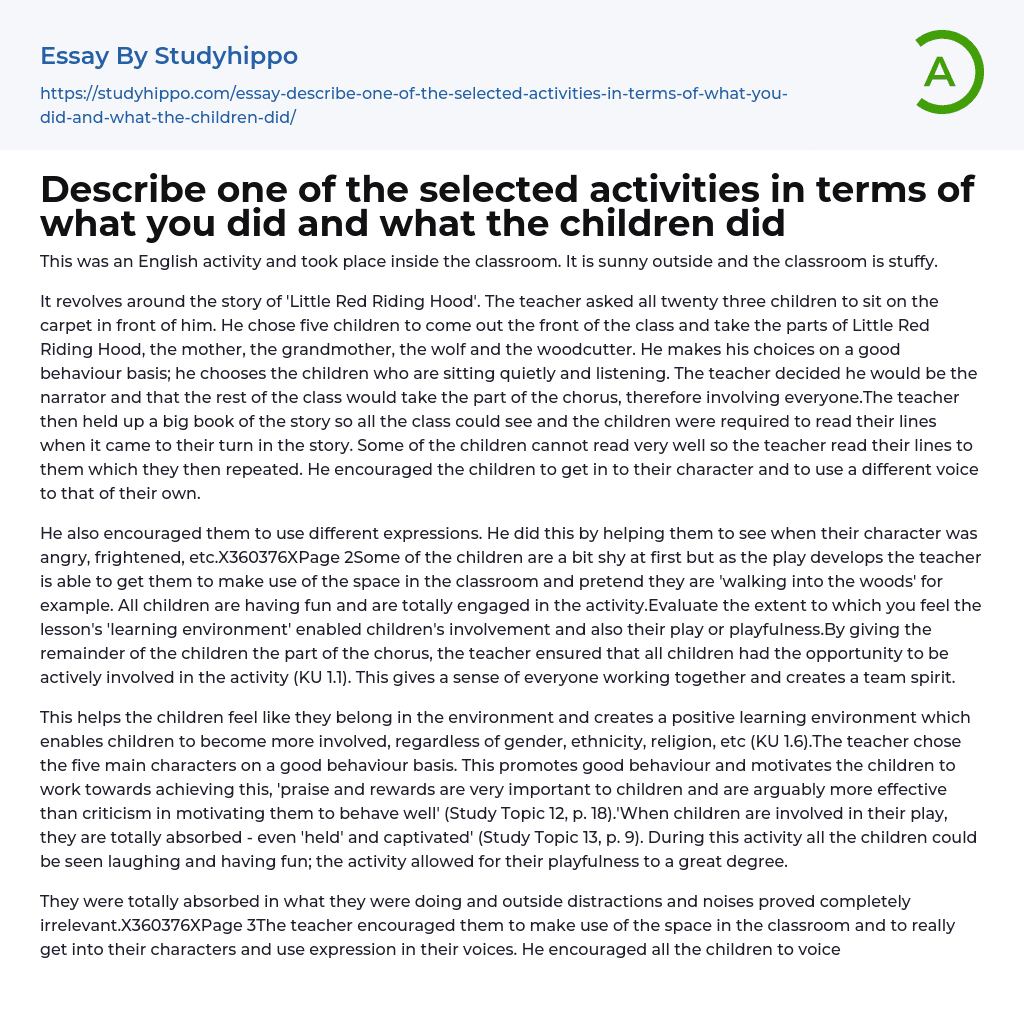The English activity occurred indoors in a stuffy classroom, while outside it was sunny.
The teacher instructed all twenty three children to gather on the carpet in front of him for a performance centered around the tale of 'Little Red Riding Hood'. Out of the group, he selected five children to portray the roles of Little Red Riding Hood, the mother, the grandmother, the wolf, and the woodcutter. This selection was based on their good behavior and attentive listening. The teacher himself took on the role of the narrator, while the rest of the class became the chorus, ensuring everyone's involvement in the activity. To provide visual aid, the teacher displayed a large book containing the story for all to see. Each child was assigned lines to read aloud when their part came up. For those who struggled with reading, the teacher stepped in and read their l
...ines for them to repeat. Additionally, he encouraged the children to fully immerse themselves in their characters and use different voices than their own.
The instructor motivated the kids to utilize diverse expressions by assisting them in identifying their character's feelings, such as rage or terror. Some of the children initially appeared timid, but with the progression of the play and through teacher’s guidance, they learned to use classroom space and envision scenarios like 'venturing into a forest'. The experience was enjoyable for all children and they participated wholeheartedly.
Assess how much you think the learning environment of this lesson helped promote engagement among children and enhance their ability to role-play. By assigning roles within the chorus to other students, it ensured every child had an active involvement in this
activity (KU 1.1). This strategy fostered a sense of camaraderie and cooperation among all participants.
Promoting a sense of belonging and fostering a positive learning atmosphere encourages children to take part, irrespective of their gender, ethnicity, religion and so on (KU 1.6). The teacher chose the five principal characters based on good conduct, encouraging positive behavior and inspiring children to pursue it since "children place great importance on praise and rewards; they are arguably more effective than criticism in motivating good behavior" (Study Topic 12, p. 18). Children become completely absorbed when engrossed in play (Study Topic 13, p. 9). During this activity, all children were observed having fun and laughing as the activity strongly supported their playful nature.
The students were fully engaged and unaffected by any external distractions or noises. The teacher urged them to utilize the classroom space and fully embody their characters, using expressive voices. The teacher encouraged the students to voice their thoughts on expressions and characters, asking open-ended questions throughout the story to stimulate their thinking about what might happen next. The teacher praised all the students for their contributions, which boosted their self-esteem and maintained their interest. Research suggests that positive language, like the encouraging words used by the teacher, can enhance children's learning and motivation (Study Topic 12, p. 10). Thus, I believe that the learning environment greatly facilitated the students' involvement and playfulness.
All children were actively engaged and completely absorbed in the activity and having fun. It would have been more engaging for them if they were given the opportunity to create their own lines during the activity. This would have made them feel more involved and take
ownership of their play. The teacher could have read the story to the class and let them act it out using their own words. Another option would be to let them create a completely new story with additional characters. This would have promoted exploration of new ideas and allowed them to express themselves in a playful and enjoyable environment.
This statement aligns with Piaget's theory (KU 1.3) that "young children learn from their own spontaneous exploration" (Cable and Eyres, 2005, p. 9). It is possible that the children would have gained more by reducing adult involvement. Due to limited classroom space and the pleasant weather outside, it could have been beneficial to take the children to the playground where they would have had access to fresh air and ample open space. This would have allowed them to have greater freedom of movement and increased opportunities for playful engagement (PS 3.2). Their imaginations would have been sparked, and they would have been able to fully immerse themselves in their roles.
Alan Peacock (1997) emphasized the importance of offering children opportunities to understand and connect with their surroundings (Study Topic 12, p. 29). For instance, the grass area with trees next to the playground provided an ideal setting resembling the forest in Little Red Riding Hood.
Creativity was the focus of an art activity conducted indoors. The teacher prepared the classroom by placing a large piece of blue card on each of the four tables. On top of these cards, he attached green card cutouts in the shape of maps. Additionally, various resources like cotton wool and straws were made available for the children to use.
- Classroom Management essays
- Child essays
- Child labor essays
- Childcare essays
- Classroom essays
- College essays
- E-Learning essays
- Elementary School essays
- Examination essays
- Graduate School essays
- High School essays
- History Of Education essays
- Homeschooling essays
- Kindergarten essays
- Middle School essays
- Public School essays
- School essays
- Single Sex Schools essays
- Special Education essays
- Student essays
- Teacher essays
- University essays
- Vocational Education essays




